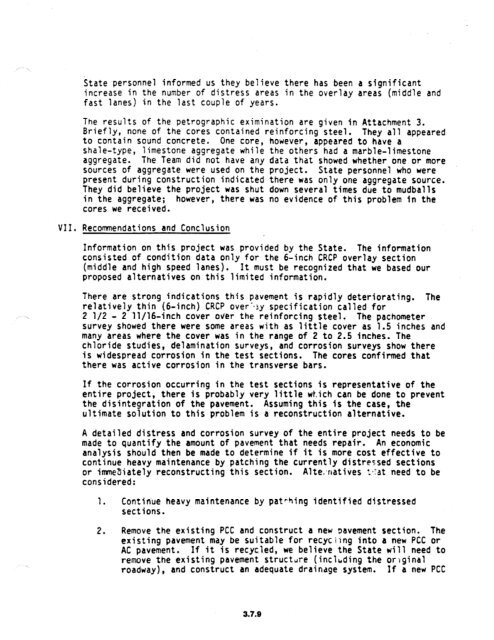chapter 3 rigid pavement - DOT On-Line Publications - Department ...
chapter 3 rigid pavement - DOT On-Line Publications - Department ...
chapter 3 rigid pavement - DOT On-Line Publications - Department ...
You also want an ePaper? Increase the reach of your titles
YUMPU automatically turns print PDFs into web optimized ePapers that Google loves.
State personnel informed us they believe there has been a significant<br />
increase in the number of distress areas in the overlay areas (middle and<br />
fast lanes) in the last couple of years.<br />
The results of the petrographic eximination are given in Attachment 3.<br />
Briefly, none of the cores contained reinforcing steel. They all appeared<br />
to contain sound concrete. <strong>On</strong>e core, however, appeared to have a<br />
shale-type, limestone aggregate while the others had a marble-limestone<br />
aggregate. The Team did not have any data that showed whether one or more<br />
sources of aggregate were used on the project. State personnel who were<br />
present during construction indicated there was only one aggregate source.<br />
They did believe the project was shut down several times due to mudballr<br />
in the aggregate; however, there was no evidence of this problem in the<br />
cores we received.<br />
VII. Recommendations and Conclusion<br />
Information on this project was provided by the State. The information<br />
consisted of condition data only for the 6-inch CRCP overlay section<br />
(middle and high speed lanes). It must be recognized that we based our<br />
proposed alternatives on this limited information.<br />
There are strong indications this <strong>pavement</strong> is rapidly deteriorating. The<br />
relatively thin (6-inch) CRCP over‘njy specification called for<br />
2 l/2 - 2 It/lb-inch cover over the reinforcing steel. The pachometer<br />
survey showed there were some areas with as little cover as 1.5 inches and<br />
many areas where the cover was in the range of 2 to 2.5 inches. The<br />
chloride studies, delamination surveys, and corrosion surveys show there<br />
is widespread corrosion in the test sections. The cores confirmed that<br />
there was active corrosion in the transverse bars.<br />
If the corrosion occurring in the test sections is representative of the<br />
entire project, there is probably very little wr.ich can be done to prevent<br />
the disintegration of the <strong>pavement</strong>. Assuming this is the case, the<br />
ultimate solution to this problem is a reconstruction alternative.<br />
A detailed distress and corrosion survey of the entire project needs to be<br />
made to quantify the amount of <strong>pavement</strong> that needs repair. An economic<br />
analysis should then be made to determine if it is more cost effective to<br />
continue heavy maintenance by patching the currently distressed sections<br />
or immediately reconstructing this section. Alte:natives :-rat need to be<br />
considered:<br />
1. Continue heavy maintenance by patrhing identified distressed<br />
sections.<br />
2. Remove the existing PCC and construct a new <strong>pavement</strong> section. The<br />
existing <strong>pavement</strong> may be suitable for recyciing into a new PCC or<br />
AC <strong>pavement</strong>. If it is recycled, we believe the State will need to<br />
remove the existing <strong>pavement</strong> structure (including the or.lginal<br />
roadway), and construct an adequate drainage system. If a new PCC<br />
3.7.9
















